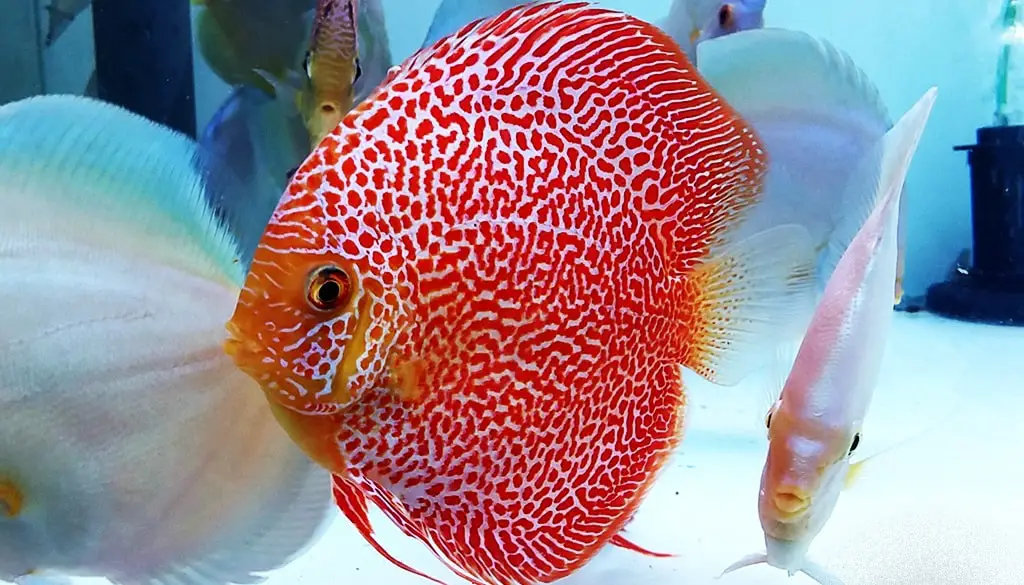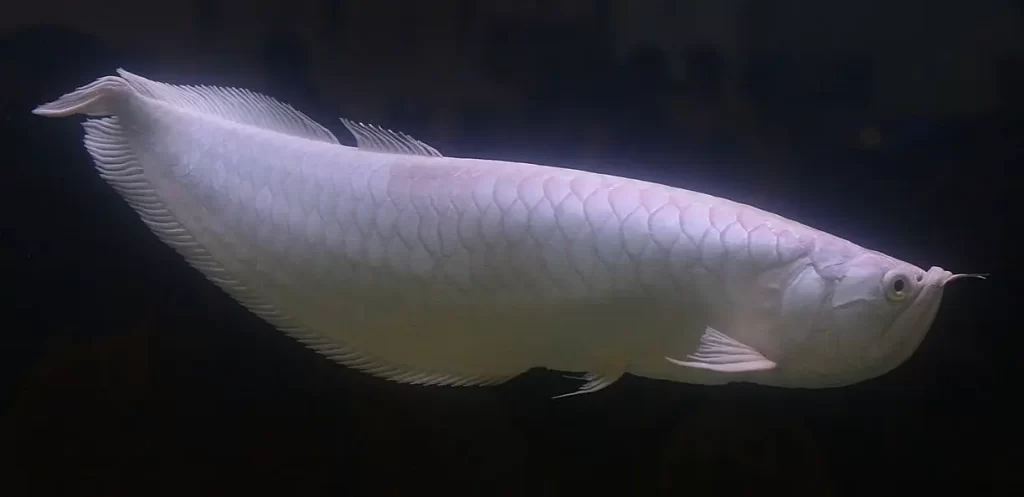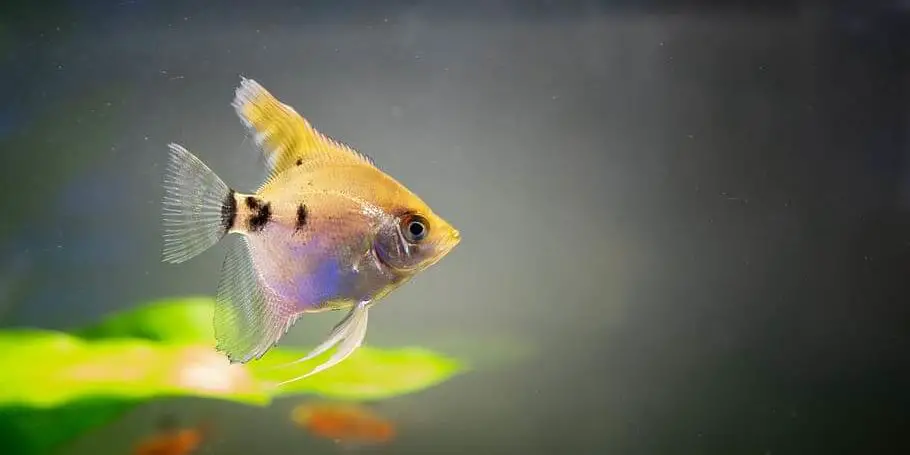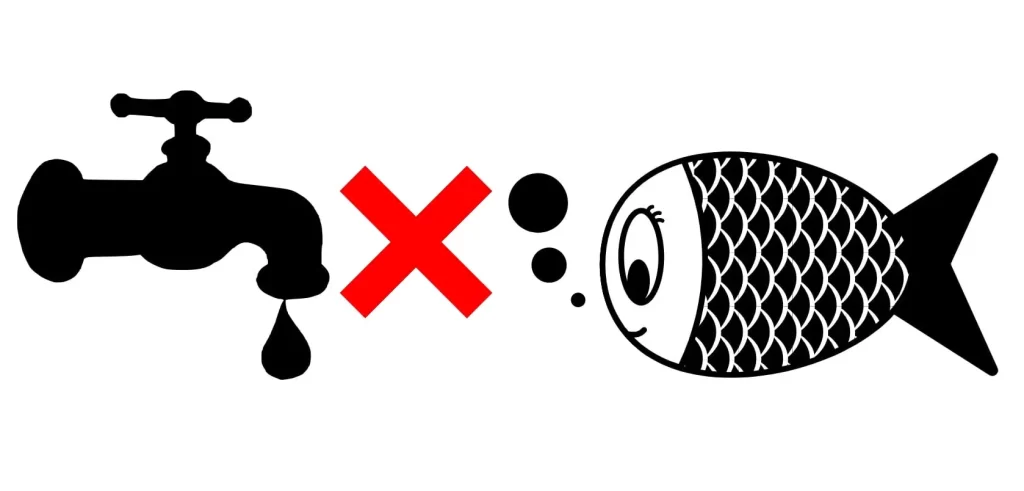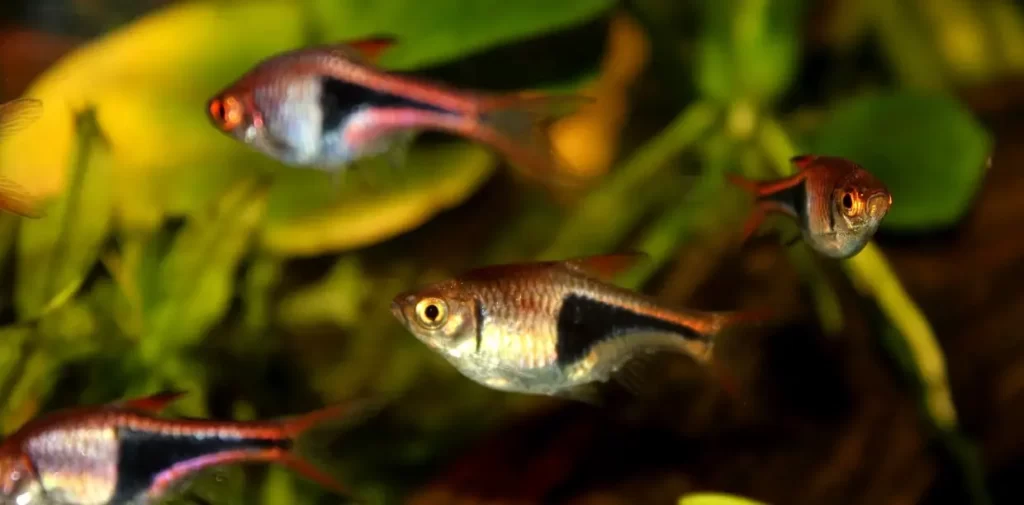Discus Fish, also known as pompadour fish, are the members of the Family Cichlidae. Having a compressed and disk-shaped body, yet their beautiful pattern and variance in colors make them a popular freshwater aquarium fish, entitling them as “The King of the aquarium.” The three species of genus Symphysodon, namely Symphysodon Discus, Symphysodon aequifasciatus, and Symphysodon tarzoo, are found naturally in the Amazon River, including its tributaries and the Rio Negro. Despite these natural habitats, the Discus is found in freshwater aquariums worldwide. With the beauty of these comes great responsibility as well. The Discuses are prone to several diseases and difficult to keep alive unless the keeper maintains the proper temperature of the water and the pH levels. Not only these, improper hygiene of the aquarium and contamination of water, and the accessories put in the tank can also lead to several diseases in the Discus.
It is essential to maintain the temperature of water between 27.778 °C and 30 °C, indicating warm water which is soft as well as acidic with gentle movement. The pH level of water ought to be between 6.0 and 7.0. On meeting these criteria regularly, a Discus is expected to live up to 15 years, growing up to 8inches in length. On failing to meet the criteria, a Discus often becomes susceptible to various external diseases like Fungal infections, Parasitic Anchor Worms, White Spot Infections, Cloudy Eye Infections, and Columnaris Disease, and internal diseases like Fish Tuberculosis, Dropsy and Popeye, Hexamitiasis, Mycobacteriosis, and Tapeworms.
Prevention is Better than Cure
As for every other fish, I believe that to keep the Discus fish alive and healthy in a freshwater aquarium, it is very important to maintain the water in the aquarium as per the need of them. The excess of nitrates, chlorine, ammonia leads to poisoning in the tank, which is the main cause of rapid breathing in a Discus fish. Proper cleansing of the aquarium and its ornaments, changing the water in the tank regularly, and keep the water temperature accordingly can prevent the Discus fish from the very common disease like lying down, a swollen belly or a hole in the head. The keeper often neglects these diseases, but it can cause severe damage to the fish, resulting in the death of the Discus.
Discus Fish Diseases and Treatments
Some common external and internal disease in a Discus fish include:
Rapid Breathing
Usually overlooked by the keeper, rapid breathing is one of the major common diseases in a Discus. It isn’t a normal behavior in the fish if the fish is normally inactive.
Symptoms
- Abnormal breathing pattern in an inactive discus fish.
- The fish swims closer to the surface of the water.
Causes
- Poisoning in the tank
- Excess of nitrates, ammonia, chloramine, or chlorine
- Lack of oxygen
Treatment
- Dechlorinate the tank in case of poisoning.
- Adjust the level of oxygen in the tank.
Prevention
- Test the level of nitrate and ammonia in the tank regularly, preferably using an aquarium test kit.
- Use an air stone to adjust the level of oxygen in the tank.
Fungal Infections (External)
Fungal infection is a common disease in Discus fish, and mostly attacks the external tissues of the fish. This comes secondary to a parasitic break or injury on the skin of the fish. A fungal infection, if not treated on time, can kill the Discus.
Symptoms
- The appearance of a cottony substance or feathery attachment on the break/wound on the body of the fish.
Causes
- Existing fungal spore in the aquarium
- Break or wounds on the skin of the fish
- Poor quality of water
- Other fishes with reoccurring fungal infections
Treatment
- Use of antibiotics like Triple Sulpha and Tetracycline.
Prevention
- Timely treatment of breaks and wounds on the skin
- Maintenance of hygiene and water quality
- Removal of dead fishes immediately
- Use of modern antifungals
- Addition of salt into the aquarium
Parasitic Anchor Worms (External)
Anchor Worm is a skin parasite, which is a large parasitic crustacean of the Lernea species, which buries its head deep into the muscle tissue of the fish.
Symptoms
- Red and inflamed skin irritation.
- Visibility of the parasite’s whitish-green threadlike body sticking out from the skin of the fish.
Causes
- Poor water quality
- Addition of a new fish in the tank, already carrying the worm
- Skipping proper quarantine
- Live aquatic plants in the tank
Treatment
- Use of potassium permanganate dips, or salt dips.
- Use of modern antiparasitic.
- Applying topical antibiotic ointment in the infected area is also proven to work against the anchor worms.
- Sanitization of the aquarium.
- Use of organophosphates or diflubenzuron with the approval of the vet.
Prevention
- Proper quarantining of any additional product in the tank
- Maintenance of cleanliness of the water
Discus Plague (External)
Discus Plague, also known as Black Disease, is caused by a virus. It is a contagious disease that occurs only in Discus and can go airborne, from one tank to another, or from one fish to another.
Symptoms
- The fish trues to scrap off the parasite by rubbing against objects.
- Rapid and heavy breathing
- Clamping of fins
- Increase of black spots on the skin
- Hiding in a dark corner, usually around the bottom or top of the tank
- Loss of appetite in the fish
- Cloudy and/or smelly water
- Jerky swimming motions
Causes
- Airborne virus
- Addition of a discus fish that had been infected with discus plague previously
- Addition of aquarium plant or tank equipment
Treatment
Although there is no specific treatment for Discus Plage disease to date, here are some general treatment procedures you can follow.
- 30%-50% water changes until cured
- Increase the temperature of water up to 33.33 °C, to improve the metabolic function of the fish and boost their immune system
- A general treatment against parasitic and fungal infections to control secondary infections
- Use of broad-spectrum antibiotics like ciprofloxacin
- Use air stones in the tank to assist the infected fish to breathe properly
Prevention
- Maintenance of water hygiene.
- Avoid adding the Discus that was previously diagnosed with the discus plague, as they can act as the medium for the transmission of the disease.
- Treat the injuries and wounds on the skin of the fish immediately.
- Quarantine the infected fish.
Cloudy Eye Infection (External)
Cloudy eye infection is a common eye fungus disease, which is an environmental issue. This disease can blind the fish by destroying its pupil. It can sometimes be considered as a symptom of other rare diseases.
Symptoms
- Cloudy and unclear eyes.
Causes
- Building up of bacteria in the water
- Poor quality of water
- High level of nitrite, ammonia, nitrate, chlorine, chloramine, salt
- Sudden fluctuation in water temperature
Treatment
- Regular change of water in the tank
- Addition of aquarium salt or chemicals like Acriflavine or Methylene blue
- Reducing ammonia level to zero
- Decontaminate the tank of chlorine and chloramine
Prevention
- Frequent testing of water for poisoning
- Regular change of water in the tank
- Maintaining the water temperature
- Maintain quality of water and its pH level
- Changing carbon filter timely
Columnaris Disease (External or Internal)
Generally known as cottonmouth, Columnaris is a very common bacterial infection, chronic or acute, in an aquarium Discus, which is often mistaken as a fungal infection. Columnaris is also referred to as a cotton wool disease, saddleback disease, or guppy disease.
Symptoms
- Bruises on the body of the Discus
- Around dorsal fin and gills, discolored gray and patchy areas can be seen. It changes to yellowish or brownish color, as the lesions progress.
- Whitish spots on the tips of the gill filaments
- Lethargic behavior and loss of appetite
- Rapid breathing or gasping
Causes
- High water temperature
- Transmission from the infected fish through the water when virulent strains are used
- Poor water quality
- Insufficient diet
Treatment
- Quarantining the fish.
- Use of drugs like chloramphenicol, nifurpirinol, nifurprazine, and oxolinic acid.
- Oral use of oxytetracycline.
- Use of vaccines.
Prevention
- Frequent testing of water for the ammonia level and nitrite level
- Regular change of water in the tank
- Maintaining the water temperature
- Maintain the pH level and oxygen level of water
- Reduction of fish density
Fish Tuberculosis (Internal)
Fish tuberculosis is an internal disease occurring in a Discus, which is a common term used to refer to mycobacteriosis. It is a secondary disease caused by the mycobacteria that are found in food remnants, aquarium gravel, and other debris.
Symptoms
- Loss of weight, followed by scale loss, ulcers, or non-specific hemorrhagic lesions in the Discus.
- Jerky movements while swimming can be noticed.
- Sore skin.
- Unusual spinal curvatures.
- Lethargic behavior.
Causes
- Poor water quality.
- High fish population density.
- Infected fishes.
Treatment
- Use of Kanamycin with Vitamin B-6
- Quarantining the infected fish
- Immediate depopulation of the tank and disinfection of the ornaments or accessories
Prevention
- Maintaining a population of fishes in the aquarium
- Avoid introducing sick fishes into the tank
- Maintaining tank hygiene
Dropsy and Popeye (Internal)
Dropsy, also known as edema or acites, is the swelling of soft tissues in a body cavity, like a swollen belly. This condition is also known as bloat. Popeye is the bulging of the eye(s) in the aquarium fish. It has different names like exophthalmos, proptosis, exorbitism, exophthalmia, or exophthalmos, but all refer to the same disease. It can be fatal if not treated timely.
Symptoms
- Swollen belly
- Lesions can be noticed
- Bulging eyes and curved spine
- Clamped fins
- Lethargic behavior and inappetence
- Change of skin color usually becomes reddish
Causes
- Aeromonas bacteria
- Poor water quality
- High level of ammonia or nitrite in the aquarium water
- A drastic change in water temperature
- Lack of proper nutrition and care of the Discus
Treatment
- Isolation of the infected fish
- Use of antibiotics like API E.M. Erythromycin, API Melafix, API Furan-2, Kanaplex
- Use of Epsom salts to ease bowel obstruction
- Maintain the water temperature (27.778 °C and 30 °C)
- Lowering the pH level.
Prevention
- Maintaining hygiene of the tank.
- Regular change of aquarium water.
- Avoid overcrowding the fishes in a tank.
- Test water regularly for poisoning.
- The proper amount of food should be given to the fish.
Hexamitiasis (Internal)
Hexamitiasis is an internal protozoan infection, which is very communicable. This parasite can be found in the intestinal tract of the Discus fish and can stay inactive for a very long time inside the body.
Symptoms
- Slimy white feces.
- Lethargic behavior and inappetence.
- Darkening of fish’s body.
- Bodyweight loss.
Causes
- Poor water quality
- Overcrowding the tank
- Deficiency of proper nutrition
- Addition of a new infected fish to the tank
Treatment
- Isolation of the infected fish.
- Use of Metronidazole, a drug.
- 50% water changes every day.
- Raising water temperature to 33.33°C and 37.78°
Prevention
- Maintaining hygiene of the tank.
- Regular change of aquarium water.
- Avoid overcrowding the fishes in a tank.
- Test the new fish for the disease.
Tapeworms (Internal)
Tapeworm infection, a parasitic segmented worm, is a very common disease in a Discus fish. They are found in the intestinal tract of this fish, and like in Hexamitiasis, the host can be unaware of the presence of the worm due to its inactivity.
Symptoms
- Lethargic behavior and inappetence.
- Digestive disorders in older fishes.
- Bodyweight loss.
Causes
- Poor water quality
- Deficiency of proper nutrition
- Addition of a new infected fish to the tank
Treatment
- Isolation of the infected fish.
- Use of the medication named Praziquantel.
- Removal of intermediate hosts.
Prevention
- Maintaining hygiene of the tank.
- Regular change of aquarium water.
- Test the new fish for the disease.
Conclusion
As per my research on the Discus fish, I would suggest the keepers be very cautious regarding the health and hygiene of this fish. As beautiful as the fish is to admire, it is equally important to nurture and be attentive towards the symptoms it might be showing, which can later lead to fatal diseases. I’m a believer of “better safe than sorry,” so I’d request the keeper to be mindful regarding the following:
- Change the aquarium water regularly.
- Maintain the water temperature in the tank.
- Check for water poisoning frequently.
- Test the new additional fish for infectious diseases. You wouldn’t want your delicate Discus to be prone to any of the fatal disease.
- Be attentive towards the behavior of the fish, as, in the early stages, many discus fish diseases can be cured immediately.
Reference
Image Credit:
- https://en.wikipedia.org/wiki/en:Creative_Commons

